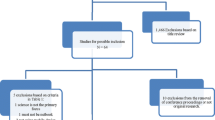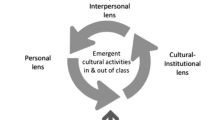Abstract
With advancements made in mobile technology, increasing emphasis has been paid to how to leverage the affordances of mobile technology to improve science learning and instruction. This paper reports on a science curriculum supported by an inquiry-based framework and mobile technologies. It was developed by teachers and researchers in a multiyear program of school-based research. The foci of this paper is on the design principles of the curriculum and its enactment, and the establishment of a teacher learning community. Through elucidating the design features of the innovative curriculum and evaluating teacher and student involvement in science instruction and learning, we introduce the science curriculum, called Mobilized 5E Science Curriculum (M5ESC), and present a representative case study of how one experienced teacher and her class adopted the curriculum. The findings indicate the intervention promoted this teacher’s questioning competency, enabled her to interact with students frequently and flexibly in class, and supported her technology use for promoting different levels of cognition. Student learning was also improved in terms of test achievement and activity performance in and out of the classroom. We propose that the study can be used to guide the learning design of mobile technology-supported curricula, as well as teacher professional development for curriculum enactment.



Similar content being viewed by others
Notes
The school academic year in Singapore comprises two semesters with each semester being constituted of two terms of about 11 weeks each.
References
Ahmed, S., & Parsons, D. (2013). Abductive science inquiry using mobile devices in the classroom. Computers & Education, 63, 62–72.
An, Y.-J., & Reigeluth, C. (2012). Creating technology-enhanced, learner-centered classrooms: K-12 teachers’ beliefs, perceptions, barriers, and support needs. Journal of Digital Learning in Teacher Education, 28(2), 54–62.
Anderson, R. D., & Helms, J. V. (2001). The ideal of standards and the reality of schools: needed research. Journal of Research in Science Teaching, 38(1), 3–16.
Arora, A. G., Kean, E., & Anthony, J. L. (2000). An interpretive study of a teacher’s evolving practice of elementary school science. Journal of Science Teacher Education, 11(2), 155–172.
Bakkenes, I., Vermunt, J. D., & Wubbels, T. (2010). Teacher learning in the context of educational innovation: learning activities and learning outcomes of experienced teachers. Learning and Instruction, 20(6), 533–548.
Becker, H. J. & Riel, M. M. (1999). Teacher professionalism and the emergence of constructivist-compatible pedagogies. Retrieved from: http://www.crito.uci.edu/TLC/findings/special_report2/index.htm.
Berth, M. (2006). Informal learning with mobile devices—moblogging as learning resource? Paper presented at Informal Learning and Digital Media: Constructions, Contexts, Consequences. 21–23 September, Odense, Denmark.
Brooks, J. G., & Brooks, M. G. (1993). In search of understanding: the case for constructivist classrooms. Alexandria: Association for Supervision and Curriculum Development.
Bybee, R. W. (2006). The BSCS 5E instructional model: origins and effectiveness. A report prepared for the Office of Science Education, National Institutes of Health. Retrieved from: http://sharepoint.snoqualmie.k12.wa.us/mshs/ramseyerd/Science%20Inquiry%201%2020112012/What%20is%20Inquiry%20Sciecne%20(long%20version).pdf.
Chin, C. (2006). Classroom interaction in science: teacher questioning and feedback to students’ responses. International Journal of Science Education, 28(11), 1315–1346.
Crawford, B. A. (2007). Learning to teach science as inquiry in the rough and tumble of practice. Journal of Research in Science Teaching, 44(4), 613–642.
Cuckle, P., & Clarke, S. (2002). Mentoring student-teachers in schools: views, practices and access to ICT. Journal of Computer Assisted Learning, 18(3), 330–340.
Cullen, R., Harris, M., & Hill, R. R. (2012). The learner-centered curriculum: design and implementation. Retrieved from: http://www.moe.gov.sg/education/syllabuses/sciences/files/science-primary-2008.pdf.
Davis, K. S. (2003). “Change is hard”: what science teachers are telling us about reform and teacher learning of innovative practices. Science Education, 87(1), 3–30.
Dede, C. (1998). The scaling-up process for technology-based educational innovations. In C. Dede (Ed.), Learning with technology (pp. 199–215). Alexandria: Association for Supervision and Curriculum Development.
Dexter, S., Seashore, K. R., & Anderson, R. E. (2002). Contributions of professional community to exemplary use of ICT. Journal of Computer Assisted Learning, 18(4), 489–497.
Donnelly, D., McGarr, O., & O’ Reilly, J. (2011). A framework for teachers’ integration of ICT into their classroom practice. Computers & Education, 57(2), 1469–1483.
Dori, Y. J., & Herscovitz, O. (2005). Case‐based long‐term professional development of science teachers. International Journal of Science Education, 27(12), 1413–1446.
Fosnot, C. T. (1996). Constructivism: a psychological theory of learning. In C. T. Fosnot (Ed.), Constructivism: theory, perspectives, and practice (pp. 8–33). New York: Teachers College.
Gedik, N., Hanci-Karademirci, A., Kursun, E., & Cagiltay, K. (2012). Key instructional design issues in a cellular phone-based mobile learning project. Computers & Education, 58(4), 1149–1159.
Greca, I. M., & Moreira, M. A. (2000). Mental models, conceptual models, and modelling. International Journal of Science Education, 22(1), 1–11.
Guy, R. (2009). The evolution of mobile teaching and learning. Santa Rosa: Informing Science.
Hadley, M., & Sheingold, K. (1993). Commonalities and distinctive patterns in teachers’ integration of computers. American Journal of Education, 101(3), 261–315.
Huang, Y.-M., Lin, Y.-T., & Cheng, S.-C. (2010). Effectiveness of a mobile plant learning system in a science curriculum in Taiwanese elementary education. Computers & Education, 54(1), 47–58.
Jimoyiannis, A. (2010). Designing and implementing an integrated technological pedagogical science knowledge framework for science teachers professional development. Computers & Education, 55(3), 1259–1269.
Jonassen, D. H., Peck, K. L., & Wilson, B. G. (1999). Learning with technology: a constructivist perspective. Upper Saddle River: Merrill/Prentice Hall.
Jones, A. C., Scanlon, E., & Clough, G. (2013). Mobile learning: two case studies of supporting inquiry learning in informal and semiformal settings. Computers & Education, 61, 21–32.
Kawalkar, A., & Vijapurkar, J. (2013). Scaffolding science talk: the role of teachers’ questions in the inquiry classroom. International Journal of Science Education, 35(12), 2004–2027.
Krajcik, J., Blumenfeld, C. P., Warx, R. W., Bass, K. M., Fredricks, J., & Soloway, E. (1998). Inquiry in project-based science classrooms: initial attempts by middle school students. Journal of the Learning Sciences, 7(3–4), 313–350.
Lavonen, J., Juuti, K., Aksela, M., & Meisalo, V. (2006). A professional development project for improving the use of information and communication technologies in science teaching. Technology, Pedagogy and Education, 15(2), 159–174.
Lee, W. O. (2013). The conceptual framework of the 21st century competencies. Keynote paper presented at the Education and 21st Century Competencies, hosted by the Ministry of Education, 22–24, September, Oman.
Looi, C.-K., Wong, L.-H., So, H.-J., Seow, P., Toh, Y., Chen, W., & Soloway, C. N. (2009). Anatomy of a mobilized lesson: learning my way. Computers & Education, 53(4), 1120–1132.
Looi, C.-K., Chen, W., & Ng, F.-K. (2010). Collaborative activities enabled by GroupScribbles (GS): an exploratory study of learning effectiveness. Computers & Education, 54(1), 14–26.
Looi, C.-K., Zhang, B., Chen, W., Seow, P., Chia, G., Norris, C., & Soloway, E. (2011). 1:1 mobile inquiry learning experience for primary science students: a study of learning effectiveness. Journal of Computer Assisted Learning, 27(3), 269–287.
Martin, F., & Ertzberger, J. (2013). Here and now mobile learning: an experimental study on the use of mobile technology. Computers & Education, 68, 76–85.
McDougall, A., & Squires, D. (1997). A framework for reviewing teacher professional development programmes in information technology. Journal of Information Technology for Teacher Education, 6(2), 115–126.
Mcrobbie, C & Tobin, K. (1995). Restraints to reform: the congruence of teacher and student actions in a chemistry classroom. Journal of Research in Science Teaching, 32(4), 373–385.
Mehan, H. (1979). Learning lessons. Cambridge: Harvard University.
Merchant, G. (2012). Mobile practices in everyday life: popular digital technologies and schooling revisited. British Journal of Educational Technology, 43(5), 770–782.
Ministry of Education. (2008). MOE launches third masterplan for ICT in education. Retrieved from: http://www.moe.gov.sg/media/press/2008/08/moe-launches-third-masterplan.php.
Ministry of Education. (2010). Nursing our young for the future. Retrieved from: http://www.moe.gov.sg/committee-of-supply-debate/files/nurturing-our-young.pdf.
Motiwalla, L. F. (2007). Mobile learning: a framework and evaluation. Computers & Education, 49(3), 581–596.
Naismith, L., Lonsdale, P., Vavoula, G., & Sharples, M. (2005). Literature review in mobile technologies and learning. A Report for NESTA Futurelab. Available from NESTA FutureLab.
National Research Council. (1996). The national science education standards. Washington, DC: National Academy.
Ng, W., & Nicholas, H. (2013). A framework for sustainable mobile learning in schools. British Journal of Educational Technology, 44(5), 695–715.
Nicol, D. J., & Macfarlane-Dick, D. (2006). Formative assessment and self‐regulated learning: a model and seven principles of good feedback practice. Studies in Higher Education, 31(2), 199–218.
Pea, R. D., & Maldonado, H. (2006). WILD for learning: interacting through new computing devices, anytime, anywhere. In K. Sawyer (Ed.), Cambridge University handbook of the learning sciences (pp. 427–442). New York: Cambridge University.
Penso, S., Shoman, E., & Shiloah, N. (2001). First steps in novice teachers’ reflective activity. Teacher Development, 5(3), 323–338.
Phelan, P., Davidson, A. L., & Cao, H. T. (1991). Students’ multiple worlds: negotiating the boundaries of family, peer and school cultures. Anthropology & Education Quarterly, 22(3), 224–250.
Puntambekar, S., & Kolodner, J. L. (2005). Toward implementing distributed scaffolding: helping students learn science from design. Journal of Research in Science Teaching, 42(2), 185–217.
Ruchter, M., Bernhard, K., & Werner, G. (2010). Comparing the effects of mobile computers and traditional approaches in environmental education. Computers & Education, 54(4), 1054–1067.
Sha, L., Looi, C.-K., Chen, W., Seow, P., & Wong, L.-H. (2012). Recognizing and measuring self-regulated learning in a mobile learning environment. Computers in Human Behavior, 28(2), 718–728.
Shih, J.-L., Chuang, C.-W., & Hwang, G.-J. (2010). An inquiry-based mobile learning approach to enhancing social science learning effectiveness. Educational Technology & Society, 13(4), 50–62.
Solvberg, A., & Rismark, M. (2012). Learning spaces in mobile learning environments. Active Learning in Higher Education, 13(1), 23–33.
Song, Y., Wong, L.-H., & Looi, C.-K. (2012). Fostering personalized learning in science inquiry supported by mobile technologies. Education Technology Research Development, 60(4), 679–701.
Starkey, L. (2011). Evaluating learning in the 21st century: a digital age learning matrix. Technology, Pedagogy and Education, 20(1), 19–39.
Sun, D., & Looi, C.-K. (2013). Designing a web-based science learning environment for model-based collaborative inquiry. Journal of Science Education and Technology, 22(1), 73–89.
Taitelbaum, D., Mamlok-Naaman, R., Carmeli, M., & Hofstein, A. (2008). Evidence for teachers’ change while participating in a continuous professional development programme and implementing the inquiry approach in the chemistry laboratory. International Journal of Science Education, 30(5), 593–617.
Thijs, A., & van den Akker, J. (Eds.). (2009). Curriculum in development. Enschede, Netherlands: SLO–Netherlands Institute for Curriculum Development. Retrieved from: http://www.slo.nl/downloads/2009/curriculum-in-development.pdf/.
van de Pol, J., Volman, M., & Beishuizen, J. (2010). Scaffolding in teacher–student interaction: a decade of research. Educational Psychology Review, 22(3), 271–296.
van den Akker, J. (2007). Curriculum design research. In T. Plomp & N. Nieveen (Eds.), An introduction to educational design research (pp. 37–51). Enschede: SLO–Netherlands Institute for Curriculum Development.
Watson, S. L., Watson, W. R., & Reigeluth, C. M. (2008). Systems design for change in education and training. In J. M. Spector, M. D. Merrill, J. G. van Merrienboer, & M. P. Driscoll (Eds.), Handbook of research on educational communications and technology (pp. 691--701). Mahwah, NJ: Lawrence Erlbaum Associates.
Wong, L.-H., & Looi, C.-K. (2011). What seams do we remove in mobile-assisted seamless learning? A critical review of the literature. Computers & Education, 57(4), 2364–2381.
Acknowledgments
The paper is based on work arising from the research project “Bridging Formal and Informal Learning Spaces for Self-directed and Collaborative Inquiry Learning in Science” funded by the Singapore National Research Foundation (NRF2011-EDU002-EL005). We would like to thank our collaborators and pilot school for working on our project.
Author information
Authors and Affiliations
Corresponding author
Rights and permissions
About this article
Cite this article
Sun, D., Looi, CK., Wu, L. et al. The Innovative Immersion of Mobile Learning into a Science Curriculum in Singapore: an Exploratory Study. Res Sci Educ 46, 547–573 (2016). https://doi.org/10.1007/s11165-015-9471-0
Published:
Issue Date:
DOI: https://doi.org/10.1007/s11165-015-9471-0




